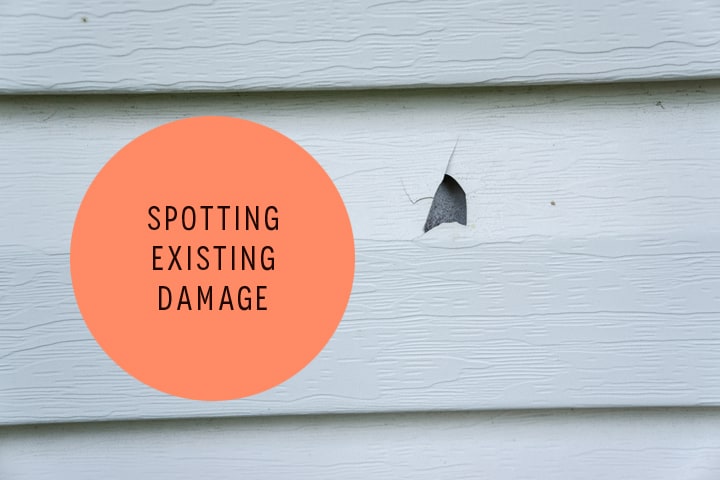Hurricane season is in full force on the East Coast, but even if you’re Colorado-based like our team, the approach of winter means extreme weather is on its way. That’s why early fall is the perfect time to inspect your home’s siding and prepare it for snow, wind, and sleet.
Though siding wear and tear occurs all year long, your home is most likely to sustain structural damage during the winter months, particularly if there are pre-existing issues, such as cracks or buckling. In order to keep your home standing firm, here are six steps you should take before winter weather strikes.
Spotting Existing Damage
The first thing you need to do to prepare you home for winter weather is examine your siding for any current damage. Do you see any cracks or warping in the siding? Warping is a clear sign of damage and indicates that your home is past due for new siding; you may even have some underlying problems, so make sure that a professional checks internal support beams and studs.
One sign of damage that is commonly overlooked is faded siding. Most people think that fading is the natural response of siding to sitting out in the sun, but in fact, it should take the better part of a decade for your home to show this type of wear.
Check Your Records
Different types of siding last different amounts of time, so even if your siding still looks like it’s holding up well, take a look at your records and determine how long it’s been since your home was re-sided. Many companies now offer 20 to 40-year warranties on vinyl siding and 25-years on cedar siding, but you may spot problems earlier than that. Fiber cement siding, on the hand, typically comes with a 25-year warranty, but it built to last longer than that. Major fiber cement siding brands like HardiePlank are water and fire-resistant.
Paint Or Prime
One of the best things you can do to protect your home’s siding is properly prime and finish it before winter weather strikes. Fall is the perfect time to do this because cooler weather allows paints and finishes to dry more quickly without interference from summer’s high humidity.
Most fiber cement siding comes primed and painted, but you can also opt to perform these steps yourself with an alkaline-resistant primer and acrylic paint. If you have wood siding, however, you’ll want to reseal it every fall to prevent damage, just as you would with a wooden deck. Wood absorbs moisture, so it needs to be treated to prevent it from rotting.
Lighten Up The Landscaping
Although aging landscaping is more likely to incur damage during the winter months, changing a few features of your landscaping can help to prevent this. For example, if you use small rocks in your garden, high winds may pick them up and cause them to collide with your siding. This can result in dents and holes. To avoid this problem, swap out the rocks in your garden for shredded mulch or bark. Though the lighter material will also fly around, it won’t cause harm to your siding.
While you’re outside, don’t forget to either anchor or put away outdoor furniture, grills, and other objects that could become projectiles. The last thing you want is for a windstorm to throw that wicker couch into your back door or crash your grill into the siding. This will leave a serious dent or worse. Since you’re unlikely to need these items in the winter anyway, put them in the shed or the garage to protect them and your home from damage.
Do A Tree Check
Winter storms are more likely to bring down weakened tree branches, especially when snow strikes early before all the leaves have fallen off the trees. Downed trees or heavy branches can then take out power lines, collide with your roof, and even give your house a beating. Make sure to check for weakened tree limbs during the early fall and get any that look precarious trimmed and removed.
If you’re being extra efficient in your winter preparations, you can have the downed branches mulched and use the resulting chips in your garden, as suggested above.
Clean The Gutters
What do your gutters have to do with siding care? Well, if your gutters are full of leaves when winter begins, ice can form in them, overflow, and push under your siding, causing the water to pour down the inner side. This is known as ice-damming and though it’s invisible to the naked eye, it can cause major problems for your home.
If your home has experienced ice-damming, it may have caused serious structural damage, ruining both the siding, which is likely to warp or crack due to moisture, and harming your home’s frame, so it’s important to have your home professionally assessed before winter strikes again.
An ounce of prevention is worth a pound of cure, so if you’re wondering if you can skip cleaning the gutters this year, now you know – it’s worth the work. Cleaning out the gutters is simple enough to do and will save you from pricey repairs.
Prepare For Winter With Home Design Exteriors
Don’t let winter weather leave you reeling; prepare for harsh conditions today with help from Home Design Exteriors. At Home Design Exteriors, we provide only the best in home care and maintenance services, offering top of the line materials like James Hardie siding, wood and fiberglass windows, and more. And of course, our team of dedicated professionals works hard for you, showing their daily commitment to outstanding service.
Not sure if your home is ready for snow, sleet, and hail? Contact Home Design Exteriors today to learn more about our services. Our representatives are on-call to assist you and can help you determine how Home Design Exteriors can meet your needs.
Don’t let ice and wind leave you chilled this winter. Home Design Exteriors will help keep you warm and dry.



